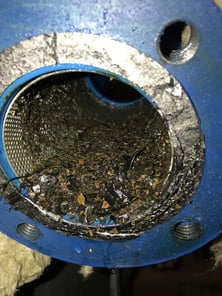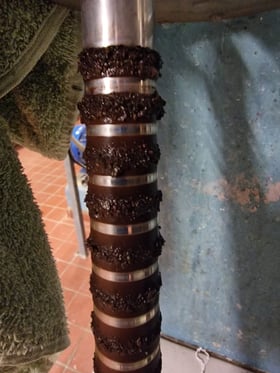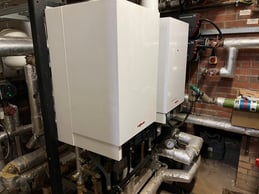In this blog, we discuss water chemistry and closed-system water treatment where the principal guidance is taken from BSRIA guide BG50:2021. This guide is intended for use by facilities managers and maintenance staff (including water treatment companies). It is consistent with BSRIA guide BG29/2021 Pre-commission cleaning of pipework systems; and BS 8552:2012 Sampling and monitoring of water from building services closed systems - Code of practice.
Introduction to Water
Firstly we need to understand something basic about water. Water is often referred to as the universal solvent; which essentially means it dissolves almost everything it comes into contact with over time.
It absorbs pollution from the air in the form of nitrogen, carbon dioxide, oxygen; and minerals from rock formations as it passes through. These minerals can vary dependent on the rock formations it meets before it enters the water system. These minerals can be calcium carbonate & calcium bicarbonate, both of which come from limestone & chalk; the result of which is an increase in scaling potential within water systems.
Water will absorb silica, iron, and manganese from sandstone and again silica from granite and it also takes with it sodium, magnesium, and potassium from seawater. All of these minerals contribute to issues with corrosion control and chemical balance in closed systems. Without testing and analysis of the water quality, you cannot determine the correct water treatment required for your system.
 Alongside the dissolved minerals, water will also contain insoluble matter such as dirt and silt; microbiological organisms, and dissolved gases. We, therefore, need to be aware of the source of the water supply, and the condition of the water, then utilise water treatment methods to control and monitor corrosion, scale formation, and sludge formation to control suspended solids and microbiological fouling.
Alongside the dissolved minerals, water will also contain insoluble matter such as dirt and silt; microbiological organisms, and dissolved gases. We, therefore, need to be aware of the source of the water supply, and the condition of the water, then utilise water treatment methods to control and monitor corrosion, scale formation, and sludge formation to control suspended solids and microbiological fouling.
So, in essence, water treatment is essential to minimise microbiological fouling, corrosion of the system and scale formation.
Corrosion Damage
So, let’s look at corrosion, damage caused by corrosion in closed heating and cooling systems is a common problem. As an integral part of a heating, ventilation, or air conditioning system, these systems circulate hot water in the winter and cold water in the summer. Maintaining the water quality within these systems directly affects the efficiencies and long-term lifecycle of, often, very expensive equipment.
Corrosion of closed systems, performance and the life expectancy of equipment and pipe work is a loss of metal from that component due to the electrochemical reaction with its environment and this term is also used to describe chemical degradation of non-metallic materials (extract from BSRIA BG 50.2021). Awell-executed water treatment programme can both maintain system efficiency and cleanliness, and extend the life of the system.
BG50:2021 explains this through:
- System design;
- Installation, testing & pre-commission cleaning;
- Application of a correct & appropriate water treatment programme;
- Effective management & testing of the programme/
Scale and micro-biological fouling
Corrosion though is not the only consideration and scale and micro-biological fouling can cause just as many issues for a closed system and must not be ignored.
In closed heating and cooling systems, water treatment comprises several techniques, including (extract from BG50:2012):
 Pre-treatment of fill water;
Pre-treatment of fill water;- Removal of dissolved gases;
- Chemical water treatment;
- pH management;
- Solids removal and filtration;
- Galvanic anodic/cathodic protection/electrochemistry;
- Bacteria and biofouling inhibition by biocides.
Chemical Treatment Systems, therefore, comprise a combination of the following:
- Corrosion inhibitors;
- Scale inhibitors;
- Organic and inorganic dispersants;
- Biocides;
- Offline chelate cleaners;
- Online cleaners.
The British Standard BS8552:2012 gives guidance on the sampling and testing of closed-circuit heating and chilled systems. A quarterly regime of testing is advocated within the British Standard.
Water Sampling & Testing
The implementation of appropriate water sampling and testing regimes will provide vital information as to the condition of the system. Traditionally, system testing may have been carried out on a less frequent basis, which could have resulted in the following potential problems:
- High bacteria levels leading to biofilm formation, under deposit corrosion, and potential degradation of some inhibitors;
- Low inhibitor levels leading to corrosion;
- High pH leading to corrosion, where Aluminium is present in the system;
- Degradation of glycol by bacteria, which can reduce the level of freeze protection required in chilled water systems;
- Build-up of scale within the system due to low inhibitor levels which can result in reduced water flows due to restrictions within pipework, and poor efficiencies of heat transfer;
- Acceleration of galvanic corrosion due to low inhibitor levels;
- Inefficient heat transfers due to the build-up of debris, corrosion deposits or scale within closed circuit system - this can also lead to higher energy bills.
Preventative Maintenance
All of the risks highlighted above can be minimised by adopting a regular quarterly regime of testing the water, followed by appropriate remedial actions if required. It has often been the case that the water treatment of closed circuit systems within buildings has not been adequately reviewed until one of these issues arises; however, preventative maintenance should always be the priority.
There are various factors which determine the correct testing regime for a system, including:
- Size of the system;
- Critical nature of the system;
- Metals of manufacture of the system;
- Analytical history of the system water.
 So remember, these systems are often expensive to install and certainly to replace should they go wrong and regular, routine analysis of the condition of the water to both BG50:2021 and BS8552:2012 will help ensure that an effective and appropriate water treatment programme is utilised to maintain and extend the life of these systems.
So remember, these systems are often expensive to install and certainly to replace should they go wrong and regular, routine analysis of the condition of the water to both BG50:2021 and BS8552:2012 will help ensure that an effective and appropriate water treatment programme is utilised to maintain and extend the life of these systems.
Feel free to reach out if you have any questions about the issues mentioned above or if you would like to consult with one of our experts on water hygiene.
Editor’s Note: The information provided in this blog is correct at the date of original publication – February 2023.
© Water Hygiene Centre 2023


.jpg?width=725&height=544&name=Closed%20System%20Analysis%20(1).jpg)






